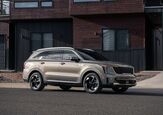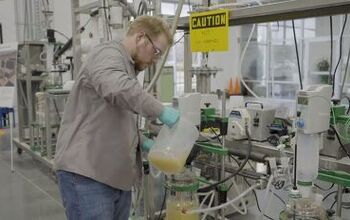No Fixed Abode: Sorry, ISeeCars, but When It Comes to Electric Car Resale, It's Still Dog Bites Man

Over the past twenty or so years, I have come to firmly believe that the largest problem facing humanity is lack of consciousness. Sounds trite, doesn’t it?
But I’m not talking about “mindfulness” or “caring” or any of that New Age woo-woo. What I mean by “consciousness” is the same thing that Douglas Hofstadter means: the ability to temporarily step outside the actions you are performing, or the thoughts you are having, and consider them from a distance, as a whole. If you can’t do that — if you are unable or unwilling to occasionally evaluate your behavior, your preconceptions, and your desires as if they belonged to someone else — then you are truly no more intelligent than a dog or a computer program or a hurricane.
The conscious individual periodically steps out outside his situation so he can consider whether what he is doing makes any sense whatsoever. You can think of it as “the state of stuckness,” as Robert Pirsig did, or you can call it a “strange loop” as Hofstadter does, but you should learn how to do it. Without that consciousness, you will always be the victim of your environment and whatever information you consume. Lack of consciousness makes people susceptible to everything from autonomous-car crashes to investment bubbles to conspiracy theories.
In this day and age, one of the biggest pitfalls facing the unconscious among us is susceptibility to so-called “fake news,” which I will define here as any news that reinforces our beliefs and cherished ideas but which cannot stand up to even a modest bit of examination. Fake news is the processed sugar of brainfood and, just like processed sugar, we consume it because it makes us feel good in the short term. (Believe me, I know.) What follows is the story of a particularly tempting morsel of processed sugar. Call it a funnel cake, maybe, one that was eagerly consumed everywhere from The Drive to CBS News.
You might think the fastest-selling used cars would be same as the most popular new cars, such as the Honda Civic or Toyota Camry. Instead, six out of 10 of the fastest-selling used cars are electrics or gas-electric hybrids, according to a new study by iSeeCars.com. The quickest-to-sell of these alternative vehicles moves in about two-thirds the time of an average used car.
Doesn’t that make you feel good? No? Well, imagine that you’re someone who sees the eventual demise of the gasoline-powered private vehicle as a necessary and inevitable social goal, and then it will make you feel good.
I’ll tell you how it made me feel, however: profoundly uneasy. Because I know that electric cars are used-lot poison that often depreciate in a staggering fashion and which have an extremely limited pool of potential buyers. So I checked out the story at iSeeCars. It took me a while to outsmart the link, which attempted to skip the actual story and take me directly to dealer sales listings, but I eventually figured out how to defeat the site (hint: don’t give it your ZIP code, no matter what) and see the list of “fastest-selling cars.” It was headed by the Fiat 500e and included the BMW i3 as well as the Nissan Leaf.
At that point, I could have done a TTAC story about the “news,” made a couple of bucks, and wandered off to play my guitar or take a nap. Instead, I tried to apply some conscious thinking to it. I had plenty of experience to tell me that electric cars rarely do well in the used market. So instead of just forwarding the feel-good study on to you, the TTAC reader, I did two things. I contacted iSeeCars to find out about their methodology, and I contacted a dealership insider who had access to the vAuto software.
vAuto gives dealers a real-time look into all sort of sales data, including average time on lot before sale. I asked my contact to get me a list of the fastest-selling automobiles out there. It didn’t contain a single one of iSeeCars’ top ten. Then I had an idea. I asked for the ten slowest sellers, the real lot lizards, the untouchables. Eight of iSeeCars’ top-ten cars were on the resulting list.
In other words, iSeeCars was telling people something that was almost precisely the opposite of the real market situation out there. I tried to apply some conscious thinking. How had this happened? Maybe their data team had accidentally reversed the list. Those sort of things happen in data science more often than anybody would like to admit, particularly in the era of NoSQL databases and query engines that use drag-and-drop graphical instructions. I asked Jacqui Trotta of iSeeCars whether perhaps her team had just reversed the list. She came back with the information that her team had run the query again and received the same results.
My next question: How does iSeeCars compile their lists? This is what I was told:
iSeeCars.com analyzed over 2.1 million used car sales from January through August, 2017. The number of days that each car was listed for sale on iSeeCars.com was aggregated at the model level and used to estimate the average days on market for late model year vehicles (model years 2014-2016). Cars with fewer than 350 listings were excluded from the analysis. For comparison, a similar analysis of one- to three-year-old vehicles (model years 2013-2015) was also run for sales from January through August, 2016. Prices from 2016 were adjusted for inflation by 2%, according to information available from the Bureau of Labor Statistics.
Well, that seems reasonable, doesn’t it? But a little bit of conscious thought allowed me to see the problem, which I’ve put in bold face for your awareness. Anybody who has worked at a dealership can tell you that there are two primary reasons that a used car disappears from the listings. The first one is obvious: it gets sold. The second one is less obvious: it gets wholesaled to the auction.
So I went back to my dealer contacts, who told me that many major franchise dealers either immediately send their electric trade-ins to auction or they list them for a very short period of time before sending them to the next large-scale auction. And then, as the apostle once said, the scales fell from my eyes. vAuto was measuring time to sale, but iSeeCars was measuring time to removal. In other words, iSeeCars could easily be counting cars that were dumped at auctions as “sales”.
A couple of discussions with dealers and dealer-affiliated personnel closed the book on this mystery for me. In the real world, electric cars are still showroom poison, they are still slow sellers at best, and they are still remarkably unpopular with consumers. In other words, dogs are still biting men and not the other way around.
How long did this common-sense investigation take me? About two hours of time total. How many other news sites performed the same analysis? Zero. Zip. Nada. How many major websites promoted the iSeeCars news story as if it were gospel truth? Let’s see:
* CBS
The list goes on, and on, and on. Not one of those outlets had somebody who could take a conscious moment and determine whether the news they were promoting made any sense whatsoever. Is that depressing? Sure. Is it an unpleasant look into how the so-called sausage is made, whether the sausage is automotive news or news in general? Sure. Is it a reminder to you that being fully conscious in an unconscious world can be a tremendous advantage? I think you know the answer to that.
[Image: Nissan]

More by Jack Baruth
Latest Car Reviews
Read moreLatest Product Reviews
Read moreRecent Comments
- Teddyc73 Doesn't matter, out of control Democrats will still do everything they can to force us to drive them.
- Teddyc73 Look at that dreary lifeless color scheme. The dull grey and black wheels and trim is infecting the auto world like a disease. Americans are living in grey houses with grey interiors driving look a like boring grey cars with black interiors and working in grey buildings with grey interiors. America is turning into a living black and white movie.
- Jalop1991 take longer than expected.Uh-huh. Gotcha. Next step: acknowledging that the fantasies of 2020 were indeed fantasies, and "longer than expected" is 2024 code word for "not gonna happen at all".But we can't actually say that, right? It's like COVID. You remember that, don't you? That thing that was going to kill the entire planet unless you all were good little boys and girls and strapped yourself into your living room and never left, just like the government told you to do. That thing you're now completely ignoring, and will now deny publicly that you ever agreed with the government about.Take your "EV-only as of 2025" cards from 2020 and put them in the same file with your COVID shot cards.
- Jalop1991 Every state. - Alex Roy
- CanadaCraig My 2006 300C SRT8 weighs 4,100 lbs. The all-new 2024 Dodge Charge EV weighs 5,800 lbs. Would it not be fair to assume that in an accident the vehicles these new Chargers hit will suffer more damage? And perhaps kill more people?


































Comments
Join the conversation
When it comes to 3rd party data, analytics and interpretation, I’ll take carelessness over intent 19 times out of 20.
A few years back there was a “news” list story about the snobbiest town in Michigan. Northville was Number 1, which while plausible it seemed unlikely to me. Some of the other cities listed in the top 10 were also suspect. I tried to figure out their methodology but it was poorly defined and vague. So I dug a little more and noticed that the first letter of every city on their list was N-Z. So they somehow left out all those A-M cities like Birmingham and Grosse Pointe Shores.